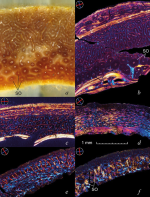albertonykus
Well-known member
Dobrovolsky, S. and L. Gorobets (2023)
Growth duration, life history and ecological traits of bony-toothed birds (Odontopterygiformes): implications from bone histology
Geo & Bio 24: 141–158
doi: 10.53452/gb2409
Bony-toothed birds (Odontopterygiformes), an order of seabirds that existed throughout most of the Cenozoic, had unusually fragile, thin-walled bones. This complicates their study and draws attention to microscopic methods, which are applicable even to fragmentary remains. The histological structure of long bones of the limbs of two species from the lower Lutetian locality Ikove (Luhansk Oblast, Ukraine) was studied: Lutetodontopteryx tethyensis and cf. Dasornis sp., representing the two main clades of the order. The well-preserved microstructure of the bones sheds light on the growth pattern of these birds, which turned out to be similar to that of recent Neognathae: with rapid and typically sharply terminated bone growth. This resulted in the apposition of azonal woven-parallel tissue, covered with outer and inner circumferential layers (OCL and ICL), usually sharply delimited from it. Like in other birds, osteohistological features allow to distinguish gross developmental stages of the animals (juveniles, young adults, and older adults) and provide hints about events of their life history, such as egg-laying or moulting, which enhance the development of resorption cavities and, probably, secondary osteons. The humeri of L. tethyensis show a structure of the outer cortex unusual for birds, which indicates a less abrupt than usual growth cessation. Age determination from the sub-layers in the inner circumferential layer (a method which works in some species of recent birds but not in other) proved impossible for L. tethyensis; for cf. Dasornis sp. the question remains open. The duration of the growth in the studied species cannot currently be determined precisely, but can be estimated at 10^2 days, probably (in contrast to previous inferences) less than one year. A relatively short development supports the hypothesis about Odontopterygiformes being specialised consumers of squid, based on the morphology of the pseudoteeth. Eating squid can be an explanation of the observed osteohistological features, which could be caused by calcium deficiency.
Growth duration, life history and ecological traits of bony-toothed birds (Odontopterygiformes): implications from bone histology
Geo & Bio 24: 141–158
doi: 10.53452/gb2409
Bony-toothed birds (Odontopterygiformes), an order of seabirds that existed throughout most of the Cenozoic, had unusually fragile, thin-walled bones. This complicates their study and draws attention to microscopic methods, which are applicable even to fragmentary remains. The histological structure of long bones of the limbs of two species from the lower Lutetian locality Ikove (Luhansk Oblast, Ukraine) was studied: Lutetodontopteryx tethyensis and cf. Dasornis sp., representing the two main clades of the order. The well-preserved microstructure of the bones sheds light on the growth pattern of these birds, which turned out to be similar to that of recent Neognathae: with rapid and typically sharply terminated bone growth. This resulted in the apposition of azonal woven-parallel tissue, covered with outer and inner circumferential layers (OCL and ICL), usually sharply delimited from it. Like in other birds, osteohistological features allow to distinguish gross developmental stages of the animals (juveniles, young adults, and older adults) and provide hints about events of their life history, such as egg-laying or moulting, which enhance the development of resorption cavities and, probably, secondary osteons. The humeri of L. tethyensis show a structure of the outer cortex unusual for birds, which indicates a less abrupt than usual growth cessation. Age determination from the sub-layers in the inner circumferential layer (a method which works in some species of recent birds but not in other) proved impossible for L. tethyensis; for cf. Dasornis sp. the question remains open. The duration of the growth in the studied species cannot currently be determined precisely, but can be estimated at 10^2 days, probably (in contrast to previous inferences) less than one year. A relatively short development supports the hypothesis about Odontopterygiformes being specialised consumers of squid, based on the morphology of the pseudoteeth. Eating squid can be an explanation of the observed osteohistological features, which could be caused by calcium deficiency.





